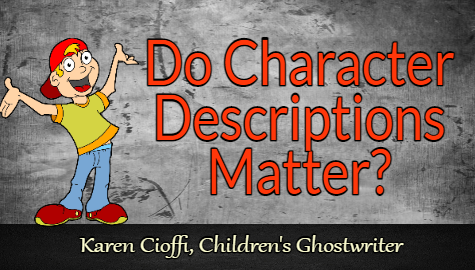To answer the title question, character descriptions are essential.
It’s these descriptions that give the reader insight into the character and let the reader know:
-What type of person she is
-What his family is like
-What his education status is
-What her hobbies are
-What she’s passionate about
-What she’s afraid of
-What his physical details are
-What his social standing is
-Where she lives
The list can go on to include talents, sports, beliefs, and so much more if the story calls for it.
Just a simple description of a character drawing tells the reader about him. Maybe he’s artistic. Whether he’s talented at it or not will reveal element of his personality.
Suppose he’s terrible at drawing but does it anyway. What can that tell the reader about him? Possibly, he’s determined. He may march to his own drum, or he just likes it and doesn’t care about excelling in it.
Maybe another character studies all the time and gets all As. Perhaps someone else in that character’s class studies all the time and barely passes. This gives a big clue as to the ‘character’ of these characters. The one who gets all As is driven. The one who barely passes may not be driven in the same way but knows that without struggling, she’ll fail.
What if a character is always yelled at and put down by his father? Might that help the reader understand the character’s behavioral issues?
EXAMPLES
-In the first couple of pages of the middle-grade Walking Through Walls, the main character Wang is described as being disgruntled. He doesn’t like hard work. He’s impatient, and he fights with his sister.
Right off the bat, the reader knows a lot about this character. The reader may even be able to see himself in the character. This makes a connection.
–What if a description shows that a character is disabled and in a wheelchair but strives to do everything she physically can, even playing sports? What does this tell you about the character?
–How about a description of a teen character lifting weights? This simple activity, combined with a couple of other details, can tell you a lot about his physical and emotional state.
Maybe he wants to be strong and look good. Maybe he’s physically weak and is being bullied. He may want to be able to protect himself, take care of himself. It could even be the emotional side of it; he doesn’t want to appear weak.
–How about a cross country runner or competitive swimmer? The first thing the reader may think of is that the character has physical stamina.
Another layer of the character could be the reason why he does such strenuous activity. Does he simply love it? Or does he have ADHD or a depressive personality, and the rigorous routine helps him?
Providing character descriptions will help the reader connect with the character. Hopefully, it will help create a strong connection. It will help the reader form a vested interest in what happens to the character. It will make the reader root for the character and keep turning the pages.
So, the next time you’re creating your character, be sure to think about how you can add descriptions to create a multi-dimensional character that will bring that character to life.
I’m a working children’s ghostwriter, editor, and coach. I can help turn your story into a book you’ll be proud to be the author of, one that’s publishable and marketable.
OTHER HELP I OFFER:
FICTION WRITING FOR CHILDREN COURSE
A guided self-study course and mentoring program.
HOW TO WRITE A CHILDREN’S FICTION BOOK
A DIY book to help you write your own children’s book.
WRITERS ON THE MOVE PRESS.
Self-publishing help for children’s authors.
You can contact me at: kcioffiventrice@gmail.com. Or give me a call at 347—834—6700. (Please leave a message- I’ll get back to you as soon as I can.)
Children’s Books and Back Matter
Creating Story Characters – Avoid These Common Mistakes




Love how you give examples after your tips, @Karen Cioffi!
Very best,
Carolyn Howard-Johnson
#TheFrugalBookPromoter
Thanks, Carolyn. I’m so glad they’re helpful!